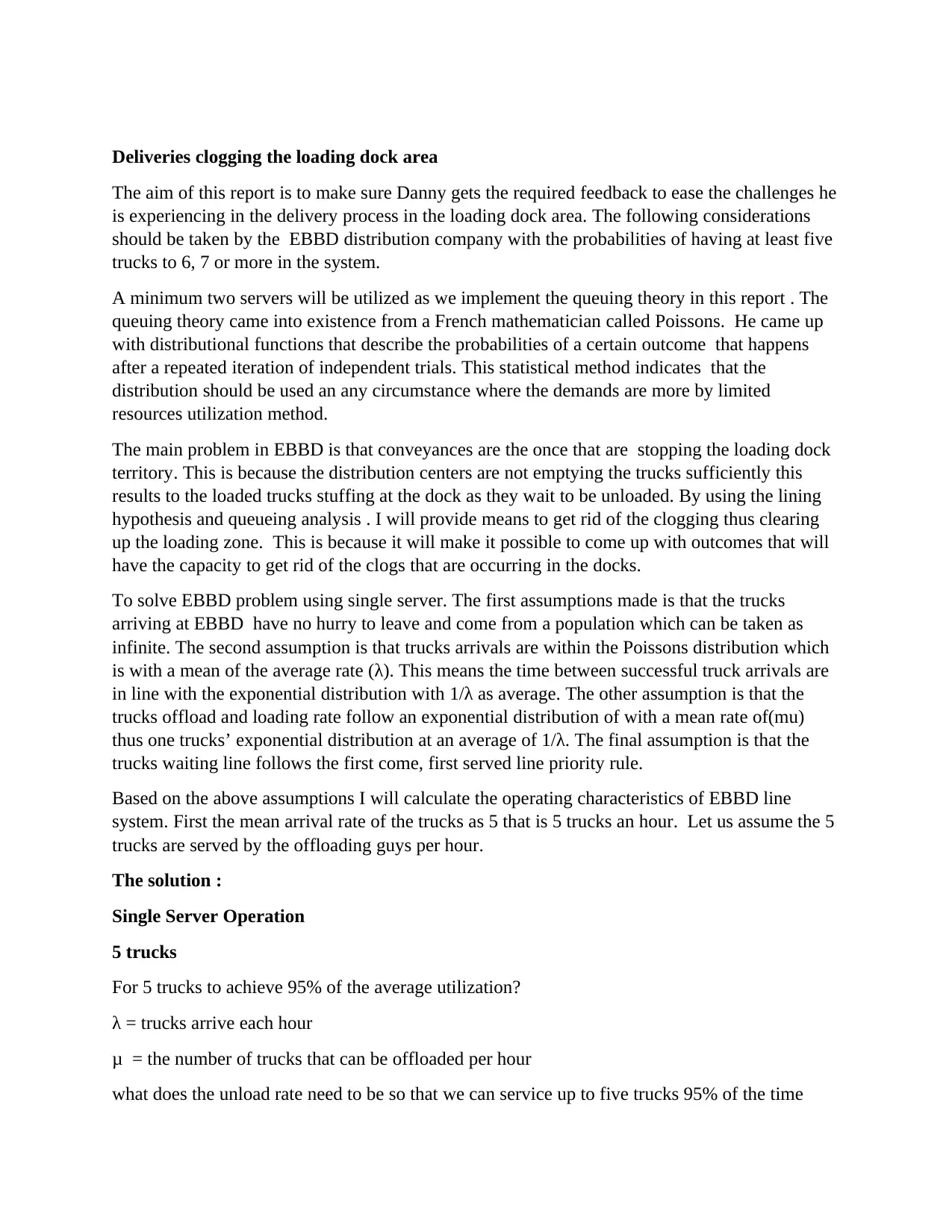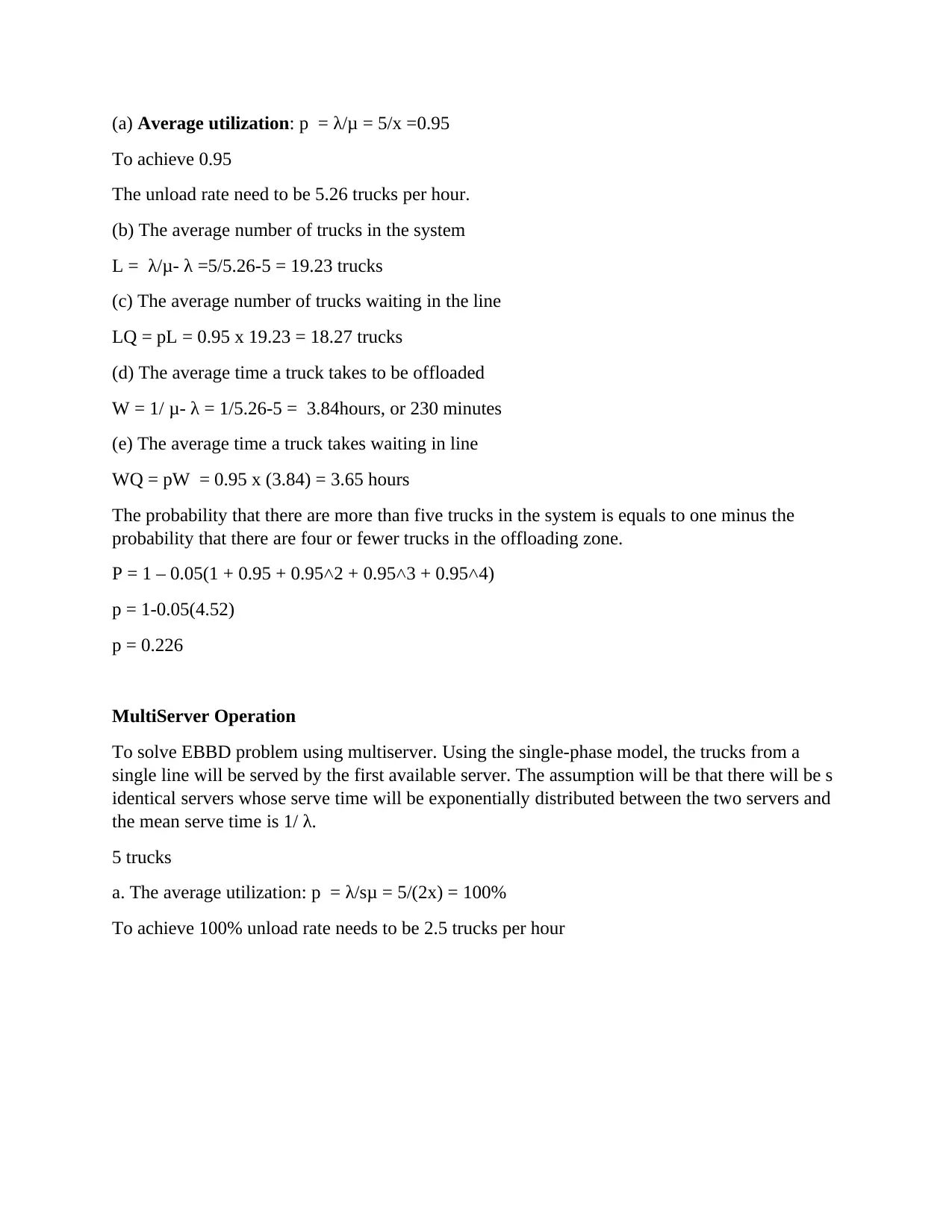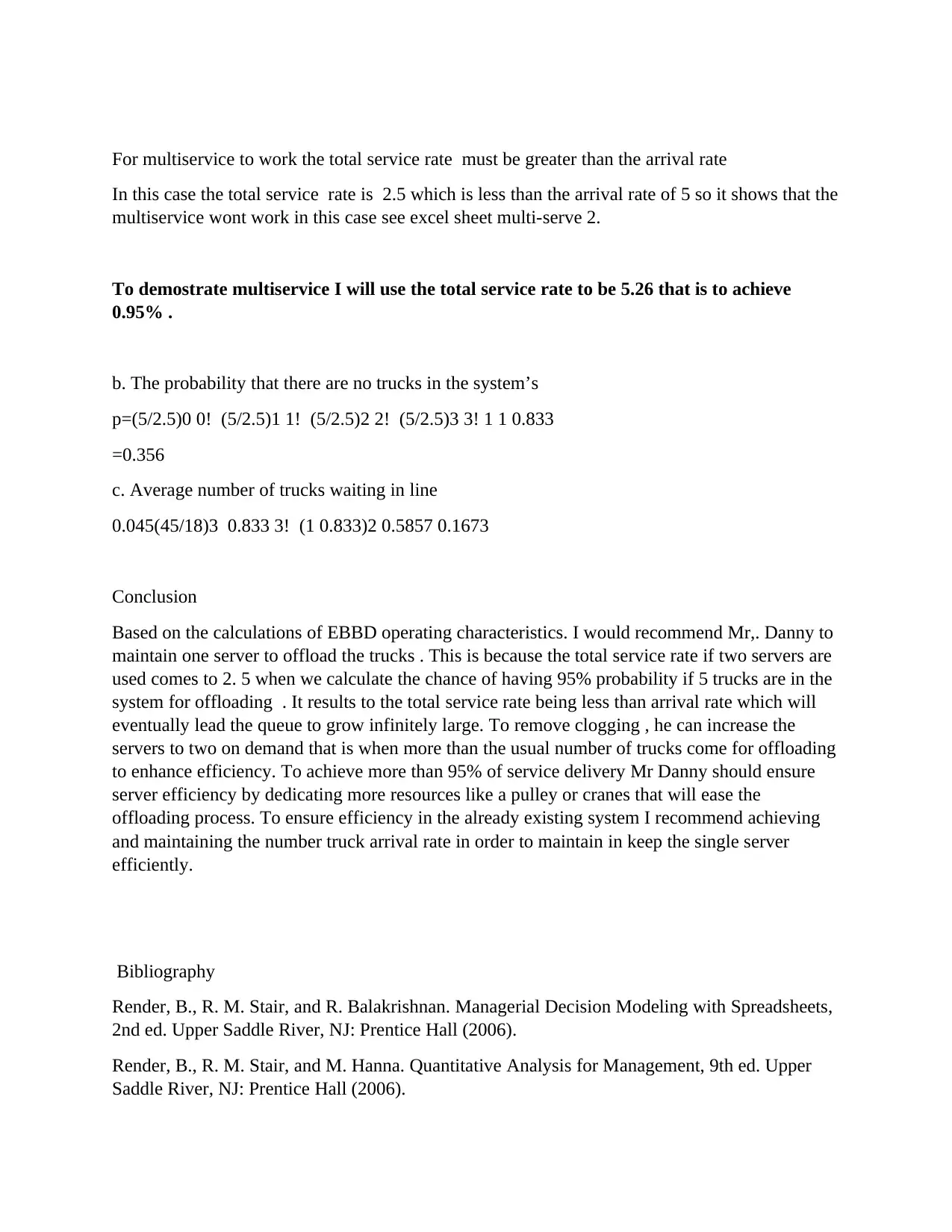Distributional Functions And Probabilities
VerifiedAdded on 2022/08/17
|4
|1137
|10
AI Summary
Contribute Materials
Your contribution can guide someone’s learning journey. Share your
documents today.

Deliveries clogging the loading dock area
The aim of this report is to make sure Danny gets the required feedback to ease the challenges he
is experiencing in the delivery process in the loading dock area. The following considerations
should be taken by the EBBD distribution company with the probabilities of having at least five
trucks to 6, 7 or more in the system.
A minimum two servers will be utilized as we implement the queuing theory in this report . The
queuing theory came into existence from a French mathematician called Poissons. He came up
with distributional functions that describe the probabilities of a certain outcome that happens
after a repeated iteration of independent trials. This statistical method indicates that the
distribution should be used an any circumstance where the demands are more by limited
resources utilization method.
The main problem in EBBD is that conveyances are the once that are stopping the loading dock
territory. This is because the distribution centers are not emptying the trucks sufficiently this
results to the loaded trucks stuffing at the dock as they wait to be unloaded. By using the lining
hypothesis and queueing analysis . I will provide means to get rid of the clogging thus clearing
up the loading zone. This is because it will make it possible to come up with outcomes that will
have the capacity to get rid of the clogs that are occurring in the docks.
To solve EBBD problem using single server. The first assumptions made is that the trucks
arriving at EBBD have no hurry to leave and come from a population which can be taken as
infinite. The second assumption is that trucks arrivals are within the Poissons distribution which
is with a mean of the average rate (λ). This means the time between successful truck arrivals are
in line with the exponential distribution with 1/λ as average. The other assumption is that the
trucks offload and loading rate follow an exponential distribution of with a mean rate of(mu)
thus one trucks’ exponential distribution at an average of 1/λ. The final assumption is that the
trucks waiting line follows the first come, first served line priority rule.
Based on the above assumptions I will calculate the operating characteristics of EBBD line
system. First the mean arrival rate of the trucks as 5 that is 5 trucks an hour. Let us assume the 5
trucks are served by the offloading guys per hour.
The solution :
Single Server Operation
5 trucks
For 5 trucks to achieve 95% of the average utilization?
λ = trucks arrive each hour
μ = the number of trucks that can be offloaded per hour
what does the unload rate need to be so that we can service up to five trucks 95% of the time
The aim of this report is to make sure Danny gets the required feedback to ease the challenges he
is experiencing in the delivery process in the loading dock area. The following considerations
should be taken by the EBBD distribution company with the probabilities of having at least five
trucks to 6, 7 or more in the system.
A minimum two servers will be utilized as we implement the queuing theory in this report . The
queuing theory came into existence from a French mathematician called Poissons. He came up
with distributional functions that describe the probabilities of a certain outcome that happens
after a repeated iteration of independent trials. This statistical method indicates that the
distribution should be used an any circumstance where the demands are more by limited
resources utilization method.
The main problem in EBBD is that conveyances are the once that are stopping the loading dock
territory. This is because the distribution centers are not emptying the trucks sufficiently this
results to the loaded trucks stuffing at the dock as they wait to be unloaded. By using the lining
hypothesis and queueing analysis . I will provide means to get rid of the clogging thus clearing
up the loading zone. This is because it will make it possible to come up with outcomes that will
have the capacity to get rid of the clogs that are occurring in the docks.
To solve EBBD problem using single server. The first assumptions made is that the trucks
arriving at EBBD have no hurry to leave and come from a population which can be taken as
infinite. The second assumption is that trucks arrivals are within the Poissons distribution which
is with a mean of the average rate (λ). This means the time between successful truck arrivals are
in line with the exponential distribution with 1/λ as average. The other assumption is that the
trucks offload and loading rate follow an exponential distribution of with a mean rate of(mu)
thus one trucks’ exponential distribution at an average of 1/λ. The final assumption is that the
trucks waiting line follows the first come, first served line priority rule.
Based on the above assumptions I will calculate the operating characteristics of EBBD line
system. First the mean arrival rate of the trucks as 5 that is 5 trucks an hour. Let us assume the 5
trucks are served by the offloading guys per hour.
The solution :
Single Server Operation
5 trucks
For 5 trucks to achieve 95% of the average utilization?
λ = trucks arrive each hour
μ = the number of trucks that can be offloaded per hour
what does the unload rate need to be so that we can service up to five trucks 95% of the time
Secure Best Marks with AI Grader
Need help grading? Try our AI Grader for instant feedback on your assignments.

(a) Average utilization: p = λ/μ = 5/x =0.95
To achieve 0.95
The unload rate need to be 5.26 trucks per hour.
(b) The average number of trucks in the system
L = λ/μ- λ =5/5.26-5 = 19.23 trucks
(c) The average number of trucks waiting in the line
LQ = pL = 0.95 x 19.23 = 18.27 trucks
(d) The average time a truck takes to be offloaded
W = 1/ μ- λ = 1/5.26-5 = 3.84hours, or 230 minutes
(e) The average time a truck takes waiting in line
WQ = pW = 0.95 x (3.84) = 3.65 hours
The probability that there are more than five trucks in the system is equals to one minus the
probability that there are four or fewer trucks in the offloading zone.
P = 1 – 0.05(1 + 0.95 + 0.95˄2 + 0.95˄3 + 0.95˄4)
p = 1-0.05(4.52)
p = 0.226
MultiServer Operation
To solve EBBD problem using multiserver. Using the single-phase model, the trucks from a
single line will be served by the first available server. The assumption will be that there will be s
identical servers whose serve time will be exponentially distributed between the two servers and
the mean serve time is 1/ λ.
5 trucks
a. The average utilization: p = λ/sμ = 5/(2x) = 100%
To achieve 100% unload rate needs to be 2.5 trucks per hour
To achieve 0.95
The unload rate need to be 5.26 trucks per hour.
(b) The average number of trucks in the system
L = λ/μ- λ =5/5.26-5 = 19.23 trucks
(c) The average number of trucks waiting in the line
LQ = pL = 0.95 x 19.23 = 18.27 trucks
(d) The average time a truck takes to be offloaded
W = 1/ μ- λ = 1/5.26-5 = 3.84hours, or 230 minutes
(e) The average time a truck takes waiting in line
WQ = pW = 0.95 x (3.84) = 3.65 hours
The probability that there are more than five trucks in the system is equals to one minus the
probability that there are four or fewer trucks in the offloading zone.
P = 1 – 0.05(1 + 0.95 + 0.95˄2 + 0.95˄3 + 0.95˄4)
p = 1-0.05(4.52)
p = 0.226
MultiServer Operation
To solve EBBD problem using multiserver. Using the single-phase model, the trucks from a
single line will be served by the first available server. The assumption will be that there will be s
identical servers whose serve time will be exponentially distributed between the two servers and
the mean serve time is 1/ λ.
5 trucks
a. The average utilization: p = λ/sμ = 5/(2x) = 100%
To achieve 100% unload rate needs to be 2.5 trucks per hour

For multiservice to work the total service rate must be greater than the arrival rate
In this case the total service rate is 2.5 which is less than the arrival rate of 5 so it shows that the
multiservice wont work in this case see excel sheet multi-serve 2.
To demostrate multiservice I will use the total service rate to be 5.26 that is to achieve
0.95% .
b. The probability that there are no trucks in the system’s
p=(5/2.5)0 0! (5/2.5)1 1! (5/2.5)2 2! (5/2.5)3 3! 1 1 0.833
=0.356
c. Average number of trucks waiting in line
0.045(45/18)3 0.833 3! (1 0.833)2 0.5857 0.1673
Conclusion
Based on the calculations of EBBD operating characteristics. I would recommend Mr,. Danny to
maintain one server to offload the trucks . This is because the total service rate if two servers are
used comes to 2. 5 when we calculate the chance of having 95% probability if 5 trucks are in the
system for offloading . It results to the total service rate being less than arrival rate which will
eventually lead the queue to grow infinitely large. To remove clogging , he can increase the
servers to two on demand that is when more than the usual number of trucks come for offloading
to enhance efficiency. To achieve more than 95% of service delivery Mr Danny should ensure
server efficiency by dedicating more resources like a pulley or cranes that will ease the
offloading process. To ensure efficiency in the already existing system I recommend achieving
and maintaining the number truck arrival rate in order to maintain in keep the single server
efficiently.
Bibliography
Render, B., R. M. Stair, and R. Balakrishnan. Managerial Decision Modeling with Spreadsheets,
2nd ed. Upper Saddle River, NJ: Prentice Hall (2006).
Render, B., R. M. Stair, and M. Hanna. Quantitative Analysis for Management, 9th ed. Upper
Saddle River, NJ: Prentice Hall (2006).
In this case the total service rate is 2.5 which is less than the arrival rate of 5 so it shows that the
multiservice wont work in this case see excel sheet multi-serve 2.
To demostrate multiservice I will use the total service rate to be 5.26 that is to achieve
0.95% .
b. The probability that there are no trucks in the system’s
p=(5/2.5)0 0! (5/2.5)1 1! (5/2.5)2 2! (5/2.5)3 3! 1 1 0.833
=0.356
c. Average number of trucks waiting in line
0.045(45/18)3 0.833 3! (1 0.833)2 0.5857 0.1673
Conclusion
Based on the calculations of EBBD operating characteristics. I would recommend Mr,. Danny to
maintain one server to offload the trucks . This is because the total service rate if two servers are
used comes to 2. 5 when we calculate the chance of having 95% probability if 5 trucks are in the
system for offloading . It results to the total service rate being less than arrival rate which will
eventually lead the queue to grow infinitely large. To remove clogging , he can increase the
servers to two on demand that is when more than the usual number of trucks come for offloading
to enhance efficiency. To achieve more than 95% of service delivery Mr Danny should ensure
server efficiency by dedicating more resources like a pulley or cranes that will ease the
offloading process. To ensure efficiency in the already existing system I recommend achieving
and maintaining the number truck arrival rate in order to maintain in keep the single server
efficiently.
Bibliography
Render, B., R. M. Stair, and R. Balakrishnan. Managerial Decision Modeling with Spreadsheets,
2nd ed. Upper Saddle River, NJ: Prentice Hall (2006).
Render, B., R. M. Stair, and M. Hanna. Quantitative Analysis for Management, 9th ed. Upper
Saddle River, NJ: Prentice Hall (2006).

1 out of 4
Related Documents
Your All-in-One AI-Powered Toolkit for Academic Success.
+13062052269
info@desklib.com
Available 24*7 on WhatsApp / Email
![[object Object]](/_next/static/media/star-bottom.7253800d.svg)
Unlock your academic potential
© 2024 | Zucol Services PVT LTD | All rights reserved.
